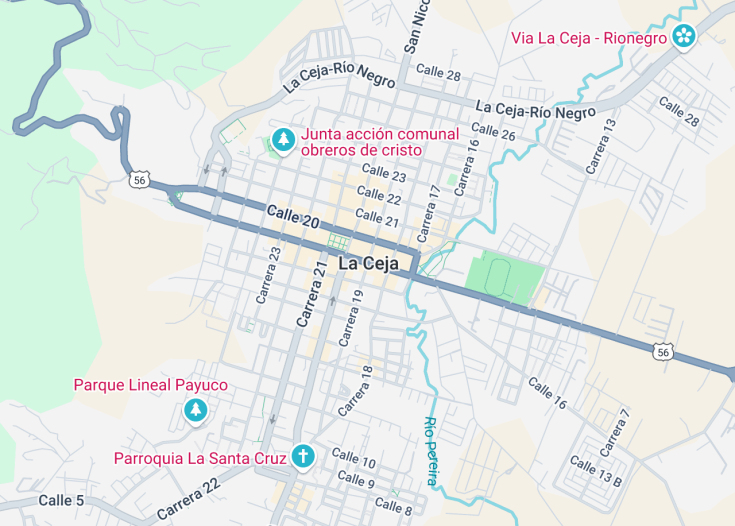La Ceja, nestled in Colombia’s Antioquia Department, offers a serene escape with its lush landscapes and rich cultural heritage. Known for its temperate climate and verdant surroundings, this picturesque town captivates visitors with colonial architecture and vibrant local traditions.
Whether you’re cycling through its welcoming streets, exploring nearby flower farms, or enjoying traditional Andean music, La Ceja serves as a charming gateway to experience the authentic Colombian highlands.
Remember to visit during July to experience the vibrant Festival of Flowers, where the town’s floricultural heritage is celebrated with parades and live music.
For a truly local experience, engage with the artisans in the town center. Their handcrafted goods offer a unique memento of your visit to La Ceja.
Top things to do & see in La Ceja
Select the following sights and activities to discover best tickets and tours available in La Ceja.
La Ceja: A Hidden Gem in the Andes
| Country | Colombia |
| Time in La Ceja | GMT-5 |
| Language spoken | Spanish |
| Population | 51,841 (based on 2021 data) |
| Currency | Colombian Peso, COP (₱) |
| Airports |
|
La Ceja, nestled within the verdant mountains of Colombia’s Antioquia department, is a vibrant town known for its striking landscapes and rich cultural heritage. At an elevation that ensures a temperate climate year-round, its natural surroundings provide a perfect backdrop for adventure and relaxation alike. Historically, La Ceja was established during the early Spanish colonial period, which has contributed significantly to its architectural and cultural outlook.
Over time, it has maintained its small-town charm and textile industry prominence while integrating modern aspects like eco-tourism and regional commerce. The town’s central plaza, surrounded by historical buildings and buzzing daily market activities, is a focal point where the traditions and community spirit of La Ceja truly shine. From biking through the mountain trails to indulging in regional Antioquian cuisine, the town offers a unique blend of experiences.
Events such as the ‘Fiestas del Toldo, las Bicicletas y las Flores,’ highlight local customs and craftsmanship, drawing visitors and artisans from around the region, making it a cultural epicenter for the area. Remnants of pre-Columbian history are also seen in nearby archaeological sites, adding layers of historical significance and attracting scholars and history buffs. Reliable transport facilities and proximity to Medellín make La Ceja accessible while providing a quieter retreat from the hustle of city life.
Where is La Ceja?
La Ceja lies in the Eastern part of the Antioquia department, nestled in the Central Cordillera of the Andes, Colombia.
Distances:
| Route | Distance by car | Time by car |
|---|---|---|
| Medellín to La Ceja | 41 miles | 1.5 hours |
| Rionegro to La Ceja | 15 miles | 35 minutes |
| El Retiro to La Ceja | 11 miles | 30 minutes |
What is La Ceja famous for?
La Ceja is renowned for its beautiful landscapes, perfect for paragliding, trekking, and enjoying the tranquil mountain atmosphere. It’s also recognized for its rich cultural offerings, including multiple festivals that celebrate local history, music, and flowers.
History
Pre-Colonial Period (Before 1541)
Before the arrival of the Spanish, the area now known as La Ceja was populated by indigenous groups belonging to the Tahamíes, who were part of the larger Caribe family. They utilized the rich land primarily for agriculture, cultivating maize and beans, and were also known for their pottery and gold craftsmanship. The region was characterized by dense forests and a rich biodiversity, which provided ample resources for the indigenous population.
Colonial Era (1541 – 1810)
The first Spanish explorers reached the area in the first half of the 16th century. By 1541, the colonization process began, introducing European agricultural practices and establishing the Catholic Church as a pivotal institution. La Ceja was officially founded on August 16, 1789, by Spanish priest Lucas Caballero Barrera, a significant event that marked the transition from a cluster of small indigenous settlements to a structured colonial village.
19th Century – Independence and Growth (1810 – 1900)
Following Colombia’s independence from Spanish rule, La Ceja underwent considerable transformation. The 19th century was a period of growth and development as the town embraced coffee cultivation, which became a cornerstone of its economy. The construction of roads and infrastructure during this era helped integrate La Ceja into the national economy, contributing to its socio-economic development.
20th Century – Modernization and Expansion (1900 – Present)
The 20th century witnessed continued growth and modernization in La Ceja. The introduction of educatioal institutions, health services, and better infrastructure paved the way for modern urban development. Today, La Ceja is recognized for its green landscapes, flower farms, and as a hub for sports, particularly cycling, given its mountainous terrains and mild weather, making it an attractive destination for both national and international visitors.
Visit La Ceja
What to see and do in La Ceja, Colombia
La Ceja offers a charming escape with its stunning landscapes and rich cultural heritage. Visitors can explore:
- Botanical Garden La Ceja: A sanctuary of local flora and fauna ideal for nature enthusiasts.
- Horseback Riding Tours: Explore the scenic routes and the lush countryside on horseback.
- Local Coffee Farms: Tour coffee plantations to learn about the bean-to-cup process and sample the local brews.
- Ecological Walks and Cycling Routes: The surrounding hills are perfect for ecological hikes and cycling, attracting sports enthusiasts year-round.
Visit notable historical sites such as the Church of Nuestra Señora del Carmen, known for its colonial architecture.
Events in La Ceja
La Ceja hosts several cultural and sporting events throughout the year including:
- The Cultural Week: Held in August, this festival features music, dance, and local cuisine, celebrating the town’s rich heritage.
- The Flower Festival: In September, the Flower Festival showcases spectacular flower arrangements and parades.
These events reflect the vibrant community spirit and provide insights into the local traditions and celebrations.
Best time to visit La Ceja
The ideal time to visit La Ceja is between December and March when the weather is dry, making it perfect for outdoor activities and exploring the natural attractions.
Additionally, visiting during the cultural events can enhance the travel experience with colorful festivities and local interactions.
Is La Ceja worth visiting?
Indeed, La Ceja is worth visiting for those who appreciate nature, culture, and history.
The town offers a unique blend of scenic beauty, rich cultural traditions, and vibrant community life. Its mild climate and diverse activities catering to different interests make it a compelling destination for travelers seeking an authentic Colombian experience.










